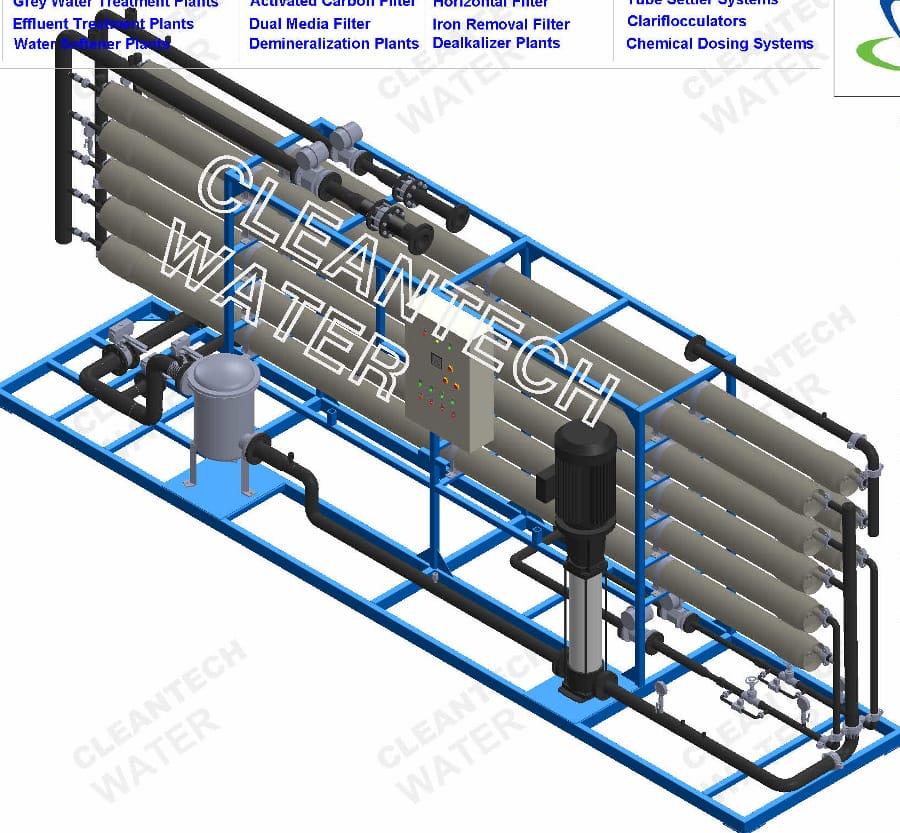 Perfectly engineered yet simple Reverse Osmosis plants by Cleantech are ideal for a wide spectrum of applications. We ensure excellent performance, stringent designs, smooth operations, and durability to our clients. Our RO plants are cost-effective because they need low maintenance. Less membrane fouling, long life of membrane and maximum recovery of permeate bring customer delight.
Perfectly engineered yet simple Reverse Osmosis plants by Cleantech are ideal for a wide spectrum of applications. We ensure excellent performance, stringent designs, smooth operations, and durability to our clients. Our RO plants are cost-effective because they need low maintenance. Less membrane fouling, long life of membrane and maximum recovery of permeate bring customer delight.
Our RO systems remove the dissolved contaminations up to the maximum possible extent. High-speed pressure pumps and best-in-the-class semi-permeable membranes achieve great results.
What Makes Our RO Plants Special?
- Wide range of plants from .25KLPH to 50KLPH
- Well-organized design
- Complete monitoring and tracking system
- The maximum TDS removal
- Long life of membranes and reduced fouling of membrane
- Excellent water quality
- Smooth operations and low maintenance requirement
- Plug and play
- Cost-effective and useful
Applications of RO-Treated Water
1. In manufacturing processes
2. Boiler feeds
3. To polish treated water
4. Hospitals and labs
What is Reverse Osmosis?
Reverse Osmosis (commonly referred to as RO) is the process of deionizing or demineralizing water by passing it through a semi-permeable membrane. Before understanding the effectiveness and need of the Reverse Osmosis process, let’s understand the process of Osmosis first. When the weaker saline solution migrates to a strong saline solution, it is called Osmosis. It is a commonly occurring phenomenon in nature with a variety of uses and applications. Our kidneys absorb water from the blood or plant roots absorb water from the soil are some examples.
Reverse Osmosis is the process in a reverse manner. Whereas the Osmosis process occurs naturally without any need for energy, you need to apply energy to perform Reverse Osmosis. The membrane used in this case allows the water molecules to pass but stops the majority of the salts and impurities dissolved in the water. Typically, it stops organic material, salts, pyrogens, and bacteria. Since it is against natural processes, you need to put a lot of energy into pushing the water through the RO membrane. It desalinates the water, lets the pure water pass through the membrane, and holds back the majority of contaminants.
Statistics say that up to 95 to 99 percent of dissolved salts get removed in the process. The more salt concentration is there in the input water stream; the higher the pressure required to pass it through the membrane.
What is the Role of RO Membrane?
When the water molecules pass through the membrane under very high pressure, they pass through it, and salts or contaminants hold back. They get discharged through the system by the reject stream. Rejected water may be drained out or sent to the feed water supply, depending on the design.
RO systems use cross-filtration and not the standard filtration where the contaminants get accumulated in the filter media. In this case, the solution passes through the filter in two different ways. Contaminated water goes in one direction and filtered water in the other. Cross-flow filtration cleans the contaminant buildup so that the membrane surface remains clean.
Effectiveness of RO System
We being the reverse osmosis plant manufacturers and suppliers pride ourselves on being considered as one of the best in town.
- It can remove up to 99% of organics, particles, ions, pyrogens, and bacteria. However, it doesn’t claim 100% removal of bacteria and viruses.
- Contaminants are rejected based on their molecular weight and size. Typically, particles of molecular weight more than 200 get rejected by a well-maintained RO system. To give an example
- It also identifies contaminants based on the ionic charge. Molecules with a high ionic charge will not pass through the membrane. Gases such as CO2 don’t have highly charged atoms, and their molecular weight is also low. Hence, they pass through the membrane. It is the reason; that RO water has a higher pH value.
Reverse Osmosis is a multipurpose, versatile method of purifying water. It can treat surface and groundwater very effectively. It can treat brackish water also. RO is ideal for both large and small flow applications.
Industries such as boiler feed, pharmaceutical, semiconductor manufacturing, metal finishing food, and beverages widely use RO water. They have a requirement for huge RO treatment plants that Cleantech is capable of providing. Our experts work with the clients to understand their needs. We suggest the best solution.
A few parameters determine the efficiency and usability of RO systems. The quality of water, flow, and pressure are some important aspects. Also, hours of operations, the temperature of water, feed pressure, permeate pressure, and concentrate pressure are also important. Feed and permeate conductivity, feed and permeate flow, and salt rejection percentage are some other parameters.
Due to excellent performance and quality of the output water, good quality Reverse Osmosis Plants are in high demand. We have a complete range of choices for customers spread across industries.

